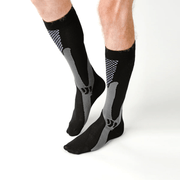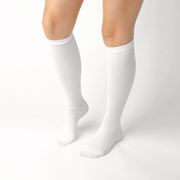Swollen feet and swollen ankles can cause discomfort, pain and difficulty walking if left unaddressed for your feet and ankles.
Many people seek tips on what to drink to reduce swelling and manage fluid retention in the lower limbs. By focusing on hydration and choosing the right beverages, you can help reduce swelling and improve blood circulation. However, if swelling occurs frequently or is accompanied by other symptoms, it’s important to seek medical advice from a healthcare professional.
This guide will cover natural drink options, nutritional strategies and supportive measures to address swelling. Whether you’re recovering from surgery, pregnant women dealing with water retention, or someone with venous insufficiency, knowing what to drink can make a meaningful difference in swelling.
Why Swelling Happens
Edema occurs when excess fluid accumulates in tissues, often in the feet and ankles and swollen area around the lower legs, resulting in noticeable swelling. This condition is also called edema and can be a sign of an underlying health condition or medical conditions such as kidney disease, heart failure or venous insufficiency, all of which contribute to ongoing swelling.
Fluid buildup can result from high blood pressure, blood clot risk, or even use of birth control pills, which may trigger water retention and further swelling. Poor blood flow and reduced blood circulation in the lower limbs exacerbate foot swelling and leg swelling, making support measures essential. Venous insufficiency develops when blood vessels fail to properly return blood to the heart, increasing the likelihood of swollen feet and swollen legs. Edema affects patients differently, with some experiencing painless swelling and others feeling tightness or heaviness in the swollen area.
Edema occurs more frequently after long periods of sitting or standing without movement, which can worsen swelling, especially in individuals with vascular issues. A physical examination and diagnostic tests by a healthcare professional can help identify the root cause of swelling and guide treatment.
Drinks That Help Reduce Swelling
-
Drinking water throughout the day is key to flushing out excess fluid and reduce swelling.
-
Aim for at least eight glasses of water daily; drinking water supports healthy blood circulation and minimizes water retention and fluid retention in the feet and ankles, reducing swelling effectively.
-
Herbal teas like dandelion, ginger or green tea can act as natural diuretics, helping fluid accumulates less and easing swelling.
-
Cranberry juice is rich in antioxidants and may support kidney function in kidney disease patients, providing extra help to reduce swelling.
-
Be mindful of sugar content and opt for unsweetened versions to avoid inflammation or high blood pressure spikes that can worsen swelling.
-
Electrolyte-balanced drinks with low sodium can manage sodium intake and salt intake, both critical to counter fluid buildup and swelling in the lower legs.
-
Many find that targeted hydration can relieve pain and support mobility in swollen feet.
Supportive Measures Beyond Drinking
-
Compression socks can complement your hydration strategy, offering graduated pressure that encourages blood flow and reduces swelling in the feet and ankles.
-
To prevent fluid retention and reduce foot swelling, wear compression socks daily, especially after drinking water.
-
Compression socks designed for medical use also help counter venous insufficiency and protect blood vessels from swelling-related damage.
-
Even after drinking water, wear compression socks for at least eight hours per day to prevent inactivity-induced swelling.
-
Alongside compression, incorporating magnesium rich foods and staying active can further reduce fluid retention and leg swelling.
-
Avoid salty foods and excessive salt intake, which can aggravate water retention and lead to more painful swelling episodes.
-
Gentle foot massage can also relieve tension and improve circulation in swollen feet.
-
Elevating your feet above heart level for short intervals throughout the day helps excess fluid travel back toward central circulation, easing swelling in the feet and swollen ankles.
-
Monitoring your blood pressure and managing high blood pressure with your healthcare professional can also reduce swelling risk.
When to Seek Medical Advice?
If swelling persists despite dietary changes and drinking water, it may signal serious medical conditions like heart failure or kidney disease requiring prompt care. Seek medical advice if swelling is accompanied by chest pain, shortness of breath or a sudden increase in a swollen area.
A healthcare professional can conduct diagnostic tests to check for blood clots or evaluate underlying health condition risk and help manage ongoing swelling. Early intervention can prevent complications, keep you mobile and reduce difficulty walking due to swelling. Report any new redness or warmth in swollen feet to your healthcare professional immediately. Keeping your feet and ankles elevated can speed recovery and reduce swelling between medical visits.
---
-
Healthline, “Home Remedies for Swollen Feet” healthline.com
-
Mayo Clinic, “Edema – Symptoms and Causes” mayoclinic.org
-
Mayo Clinic, “Leg swelling – Causes” mayoclinic.org
-
Healthfully, “Cranberry Juice for Water Retention” healthfully.com
-
Juicer Portal, “What can I drink to reduce swelling in my legs?” juicerportal.com
-
Mayo Clinic Diet, “Drinks & Beverages” diethelp.mayoclinic.org
-
Cleveland Clinic, “Swollen Feet and Ankles: Treatments to Try” health.clevelandclinic.org
-
Health.com, “What Causes Swollen Feet and Ankles?” health.com
 Active Compression
Active Compression
 Plain Compression Socks
Plain Compression Socks

